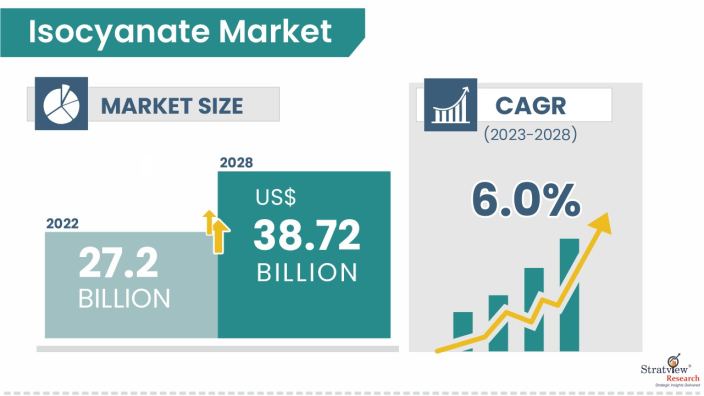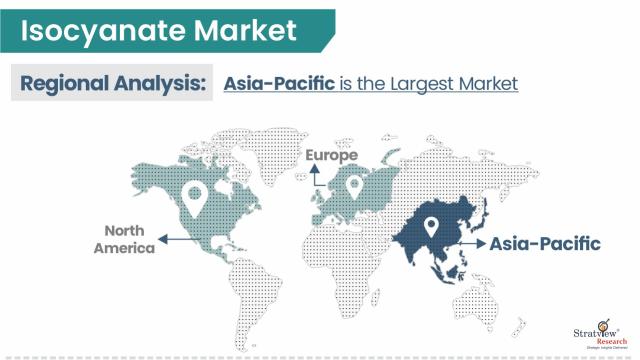Market Insights
The isocyanate market was estimated at USD 27.2 billion in 2022 and is likely to grow at a CAGR of 6.0% during 2023-2028 to reach USD 38.72 billion in 2028.

Want to know more about the market scope? Register Here
Market Dynamics
Introduction
Isocyanates are a group of highly reactive chemical compounds that contain the isocyanate functional group (-NCO). They play a crucial role in the production of polyurethane, a versatile polymer used in various industrial and consumer applications such as foams, adhesives, sealants, coatings, and elastomers.
The reactivity of isocyanates stems from the presence of the highly reactive -NCO group, which readily reacts with compounds containing hydroxyl (-OH) groups, initiating the polymerization process.
Market Drivers
While isocyanates are essential in the manufacturing of numerous products, they pose health risks to workers and consumers due to their potential to cause respiratory and skin sensitization, irritation, and, in some cases, occupational asthma. Exposure to isocyanates commonly occurs in industries such as construction, automotive manufacturing, and furniture production.
The isocyanate market is experiencing growth due to the increasing demand for polyurethane-based products in various industries. Polyurethanes, derived from isocyanates, find extensive applications in the construction, automotive, furniture, and electronics sectors. The versatility of polyurethane, offering properties such as flexibility, durability, insulation, and adhesion, is driving its adoption in manufacturing processes.
The rising construction activities, especially in emerging economies, contribute to the demand for insulation materials and coatings, wherein polyurethane plays a vital role. Additionally, the automotive industry's emphasis on lightweight materials for improved fuel efficiency and performance has boosted the use of polyurethane-based products.

Want to have a closer look at this market report? Click Here
Key Players
The following are the key players in the isocyanate market (arranged alphabetically):
- Asahi Kasei
- BASF SE
- Bayer MaterialScience
- Chemtura Corporation
- Dow Chemical Company
- Evonik Industries
- Hebei Cangzhou Dahua Group Co. Ltd.
- Huntsman Corporation
- Kumho Mitsui Chemicals Inc
- Mitsui Chemicals Inc
- Vencorex
- Yantai Wanhua Polyurethanes Co. Ltd.
Note: The above list does not necessarily include all the top players in the market.
Are you the leading player in this market? We would love to include your name. Write to us at sales@stratviewresearch.com
Segments Analysis
|
Segmentations
|
List of Sub-Segments
|
Segments with High Growth Opportunity
|
|
Type Analysis
|
Methylene diphenyl diisocyanate (MDI), Toluene diisocyanate, Aliphatic isocyanate, and Others
|
Methylene diphenyl diisocyanate (MDI) is anticipated to remain the biggest demand generator for isocyanates in the years to come.
|
|
Application Type Analysis
|
Rigid Foam, Flexible Foam, Paint & Coatings, Adhesives & sealants, Elastomers & binders, and Others
|
Flexible foam is projected to be the fastest-growing segment across the forecast period.
|
|
Regional Analysis
|
North America, Europe, Asia-Pacific, and Rest of the World
|
Asia-Pacific is expected to remain the largest and fastest-growing market over the next five years
|
By Isocyanate Type
“Methylene diphenyl diisocyanate (MDI) is anticipated to remain the biggest demand generator for isocyanates in the years to come.”
The market is segmented into methylene diphenyl diisocyanate (MDI), toluene diisocyanate (TDI), aliphatic isocyanate, and others. Methylene diphenyl diisocyanate (MDI) is experiencing growth in the isocyanate market due to its widespread use and versatility in various industries. MDI is a key component in the production of polyurethane, which is utilized in applications ranging from construction materials to automotive parts and consumer goods.
One significant factor driving the growth of the MDI segment is the expanding construction industry worldwide. MDI-based polyurethane foams are commonly used for insulation purposes in buildings, as they provide excellent thermal efficiency. The increasing emphasis on energy efficiency and sustainable construction practices has led to a higher demand for MDI-based products.
By Application Type
“Flexible foam is projected to be the fastest-growing segment across the forecast period.”
The market is segmented into rigid foam, flexible foam, paints & coatings, adhesives & sealants, elastomers & binders, and others. Flexible foam dominates the isocyanate market due to its extensive use in a wide range of industries, driven by the unique properties of polyurethane-based flexible foams derived from isocyanates. One of the key factors contributing to the dominance of flexible foam is its exceptional versatility and adaptability.
Flexible foams exhibit properties such as resilience, cushioning, and comfort, making them ideal for applications in bedding, furniture, automotive seating, and various comfort-related products. The furniture and bedding industry, in particular, extensively employs flexible foams for manufacturing mattresses, pillows, cushions, and upholstered furniture. The demand for comfortable and high-performance seating in the automotive sector further propels the use of flexible foams in car interiors.
Additionally, the growth of the e-commerce sector has increased the demand for flexible foam packaging materials due to their ability to provide effective cushioning and protection for delicate goods during transportation. This has expanded the application of flexible foams in the packaging industry.
Regional Insights
“Asia-Pacific is expected to remain the largest and fastest-growing market over the next five years.”
The market is broken down geographically into areas like North America, Europe, Asia-Pacific, and the Rest of the World (RoW). In terms of regions, the Asia-Pacific region is considered the dominating region in the isocyanate market due to several key factors that contribute to its significant market share and growth. One primary driver is the robust industrialization and rapid economic development witnessed across countries in Asia-Pacific. The region is a manufacturing hub for a diverse range of industries, including automotive, construction, furniture, and electronics, all of which heavily rely on isocyanates for polyurethane production.
Additionally, the rising population and urbanization in Asia-Pacific have led to increased construction activities, creating a substantial demand for polyurethane-based materials like insulation foams and coatings. The automotive industry in the region also plays a pivotal role, with the growing middle class driving higher car ownership rates and subsequent demand for lightweight and durable materials, such as those derived from isocyanates.
Furthermore, the supportive regulatory environment, coupled with comparatively lower production costs and labor expenses, makes the Asia-Pacific region an attractive destination for isocyanate manufacturing. The presence of key market players in countries like China and Japan further strengthens the region's dominance. Overall, the combination of industrialization, infrastructure development, and the thriving manufacturing sectors in Asia-Pacific positions it as the leading market for isocyanates, with sustained growth anticipated in the foreseeable future.

Know the high-growth countries in this report. Register Here
Research Methodology
This strategic assessment report, from Stratview Research, provides a comprehensive analysis that reflects today’s isocyanate market realities and future market possibilities for the forecast period of 2023 to 2028. After a continuous interest in our isocyanate market report from the industry stakeholders, we have tried to further accentuate our research scope to the isocyanate market to provide the most crystal-clear picture of the market. The report segments and analyses the market in the most detailed manner to provide a panoramic view of the market. The vital data/information provided in the report can play a crucial role for the market participants as well as investors in the identification of the low-hanging fruits available in the market as well as to formulate the growth strategies to expedite their growth process.
This report offers high-quality insights and is the outcome of a detailed research methodology comprising extensive secondary research, rigorous primary interviews with industry stakeholders, and validation and triangulation with Stratview Research’s internal database and statistical tools. More than 1000 authenticated secondary sources, such as company annual reports, fact books, press releases, journals, investor presentations, white papers, patents, and articles, have been leveraged to gather the data. We conducted more than 15 detailed primary interviews with the market players across the value chain in all four regions and industry experts to obtain both qualitative and quantitative insights.
Report Features
This report provides market intelligence in the most comprehensive way. The report structure has been kept such that it offers maximum business value. It provides critical insights into market dynamics and will enable strategic decision-making for existing market players as well as those willing to enter the market. The following are the key features of the report:
- Market structure: Overview, industry life cycle analysis, supply chain analysis.
- Market environment analysis: Growth drivers and constraints, Porter’s five forces analysis, SWOT analysis.
- Market trend and forecast analysis.
- Market segment trend and forecast.
- Competitive landscape and dynamics: Market share, Service portfolio, New Product Launches, etc.
- COVID-19 impact and its recovery curve
- Attractive market segments and associated growth opportunities.
- Emerging trends.
- Strategic growth opportunities for the existing and new players.
- Key success factors
Market Segmentation
This report studies the market, covering a period of 12 years of trends and forecasts. The report provides detailed insights into the market dynamics to enable informed business decision-making and growth strategy formulation based on the opportunities present in the market.
The isocyanate market is segmented into the following categories:
By Type
- Methylene diphenyl diisocyanate (MDI)
- Toluene diisocyanate
- Aliphatic isocyanate
- Others
By Application Type
- Rigid Foam
- Flexible Foam
- Paints & Coatings
- Adhesives & Sealants
- Elastomers & Binders
- Others
By Region
- North America (Country Analysis: the USA, Canada, and Mexico)
- Europe (Country Analysis: Germany, France, the UK, Russia, Spain, and Rest of Europe)
- Asia-Pacific (Country Analysis: China, Japan, India, South Korea, and Rest of Asia-Pacific)
- Rest of the World (Sub-Region Analysis: Latin America, the Middle East, and Others)

Click Here, to learn the market segmentation details.
Report Customization Options
With this detailed report, Stratview Research offers one of the following free customization options to our respectable clients:
Company Profiling
- Detailed profiling of additional market players (up to three players)
- SWOT analysis of key players (up to three players)
Competitive Benchmarking
- Benchmarking of key players on the following parameters: Product portfolio, geographical reach, regional presence, and strategic alliances.
Custom Research: Stratview Research offers custom research services across sectors. In case of any custom research requirement related to market assessment, competitive benchmarking, sourcing and procurement, target screening, and others, please send your inquiry to sales@stratviewresearch.com.

